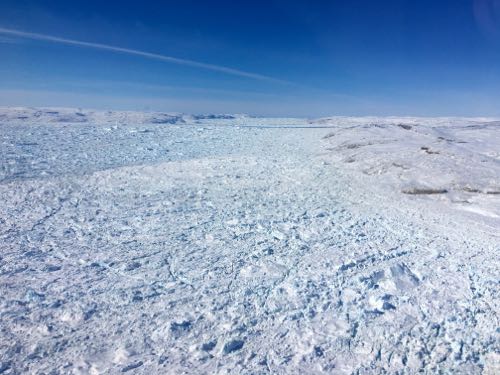Many factors make this one of my favorite days yet in the plane. The first is that I am feeling good. Yesterday was not my best day on the plane by far and it wasn't even that bumpy. I was feeling queazy for most of the flight and after a dose of air sickness medicine I was feeling sleepy. Today is a much smoother trip. Everyone is relaxed and up walking around. Some of our visitors are still here so the crew is being fun and playful, doing interviews, and talking about science. And the biggest factor that today is particularly stellar, is that today I get my first glimpse of Jakobshaven. I was told about this place during my first week in Greenland when we were still at Thule. The excitement has built up and I have not been disappointed yet. For hours we flew over the white ice sheet and then when we hit the calving front we all knew it. We could see the change in the ice. It went from smooth to being pushed up, broken, and uneven. I am a happy girl!
 Calving front at Jakobshaven Glacier in Southwest Greenland.
Calving front at Jakobshaven Glacier in Southwest Greenland.
This is only a taste of the main event. There are four missions total for this area, two of which are high priority. This glacier is huge it is the fastest flowing glacier in the Arctic. It produces 10% of all the glaciers coming from Greenland and 35 billion tons of icebergs calve off of it per year. It drains 6.5% of the Greenland Ice Sheet. It took me awhile to grasp what that means. Ice is flowing and will eventually drain from the land to the sea. It is them same idea of a watershed but this is an 'iceshed'. For my own understanding I think about it as the Everglades of ice. Having lived in Florida for about 15 years, I am familiar with the idea of a the Everglades. This area funnels the water from as far up as Orlando all the way to the bottom of Florida near Miami. The Jakobshaven glacier does the same thing. It is a 'river' of ice that covers 6.5% of Greenland and flows towards the ocean acting as a conduit for the ice and snow of Greenland to move to the coast where glaciers eventually break off into the sea.
 This is where one section of Jakobshaven Glacier meets the ocean.
This is where one section of Jakobshaven Glacier meets the ocean.
Zaria Forman (artist), Drew Denny (documentary filmmaker currently working with CNN Great Big Story), and Jenny Nichols (conservation filmmaker) are still guests with us. It is exciting to see things through their eyes. I latch on to the interviews they do of the crew. I'm like a parasite hooked onto their interviews for my own benefit. They are professionals at asking questions and I find them thinking of things that I never would. All three ladies are activists trying to communicate climate change through visual media, to as many people as they can reach. Zaria Forman explains "I want to describe the light and texture of the Polar regions in as much detail as possible, so people can experience these remote places at the forefront of climate change, and hopefully be inspired to preserve and protect them." Zaria looks at the ice sheet and through her eyes it comes alive for me. I no longer just see a calving front, which is where large chunks of ice break off from the glacier, but I also see the shapes and textures made as the ice breaks away from the glacier. I see her searching for the different colors of ice. In my mind I know that the color of the ice relates to when snow falls on a glacier and is compressed, becoming part of the glacier. Air bubbles are consequently squeezed out causing the ice crystals to enlarge, making the ice appear blue. To Zaria this is inspiration. She needs to see the fissures and the cracks, the different textures and colors in the ice. To her this is art. When she explains her vision of what she eventually wants to create I see it too. The science which creates the calving front also creates the inspiration for her art.
 Picture of the calving front of the glacier. Look at the texture of the ice and the blue color.
Picture of the calving front of the glacier. Look at the texture of the ice and the blue color.
 Picture of a glacier meeting ocean and calving of glaciers taken from the airplane window.
Picture of a glacier meeting ocean and calving of glaciers taken from the airplane window.
I am including links for Zaria Forman's website and for Jenny Nichols' website.


Comments
Add new comment